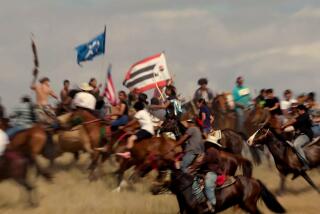The patriots who killed Custer
- Share via
Today marks the anniversary of an iconic moment of American history: Custer’s Last Stand, the culmination of Lt. Col. George Armstrong Custer’s disastrous attack on a coalition of Lakota Sioux, Cheyenne and Arapaho Indians camped on the Little Bighorn River. Nearly every American knows the image: On a dusty, bloody hill, Custer and the final survivors of his battalion fight to the last against merciless hordes of Indians who press closer at every moment.
What few Americans know is that the command of about 600 men Custer led into battle in 1876 included about 35 American Indians, mostly Arikaras but also six Crow and a few Santee Sioux. Some of the Indian scouts would die alongside the 7th Cavalry at Little Bighorn. Others would ride away as the fighting began and spend the rest of their lives recounting what little they saw of the battle. What almost no one knows is that men from the same tribes that fought against Custer would, one year later, be riding alongside the U.S. Army as scouts in the campaign against the Nez Perce -- or that the Indian scouts who served the Army in the 19th century became one of the precursors to the Army Special Forces, also known as Green Berets.
This history means that patriotism is rarely simple in the Indian country of the American Plains. American Indian communities have some of the highest rates of enlistment in the U.S. military, yet their leaders also defend the principle of tribal sovereignty -- which holds that the tribes should enjoy political and economic autonomy. So at the same time that they are sending men and women to fight on behalf of the United States, many American Indian communities continue to claim their independence from it.
At the site of the Little Bighorn battle in Montana, this contradiction becomes manifest on the anniversary of the battle. Indians from across the northern Plains come to celebrate the history of resistance to the United States, but they include color guards of Native American veterans, often in their service uniforms, carrying American flags.
In this, America’s season of intense patriotic display, those of us who are not Indians may be able to learn a few things about patriotism from the Little Bighorn celebration. The first is that American patriotism is not something that you simply have or do not. What that flag means to you will depend heavily on how you regard the history behind it.
Consider this: The Lakota Sioux offered some of the most fierce resistance to the United States in the 1860s and 1870s, but in the decades that followed, Lakota artists regularly incorporated the design of the U.S. flag into their beadwork, painting and weaving. What those stars and stripes meant to the Lakota artists could vary widely: In their hands, the U.S. flag could be a gesture of their new allegiance, a plea for justice from the U.S., a symbol of the nation for which their young men were now fighting or simply a decorative motif they knew to be popular with collectors. It might have been all of these things at the same time.
The other insight is that genuine patriotism can still take place amid divided loyalties. Americans are capable of more nuanced thinking about what it means to be an American than we usually give ourselves credit for. Non-Indians who attend celebrations like the Little Bighorn anniversary are often surprised by the exhibitions of U.S. patriotism. But for more than a century, American Indians on the Plains have understood that their love of country can contain both their struggles to achieve tribal autonomy and their deeply felt attachments to the United States.
That is the kind of patriotism that was born at the Little Bighorn battlefield, and the kind that American Indian soldiers now take with them to Afghanistan and Iraq. It is the kind of patriotism that is too big to fit on a lapel pin.
More to Read
Sign up for Essential California
The most important California stories and recommendations in your inbox every morning.
You may occasionally receive promotional content from the Los Angeles Times.










